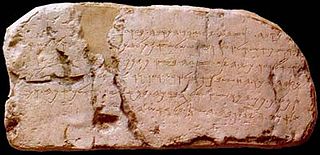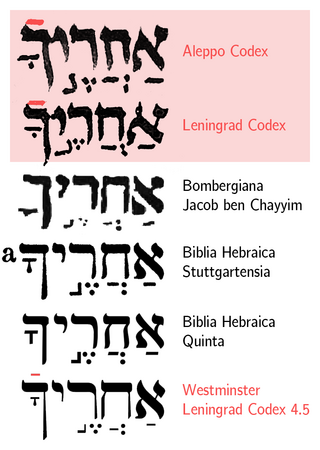
A diacritic is a glyph added to a letter or to a basic glyph. The term derives from the Ancient Greek διακριτικός, from διακρίνω. The word diacritic is a noun, though it is sometimes used in an attributive sense, whereas diacritical is only an adjective. Some diacritics, such as the acute ⟨á⟩, grave ⟨à⟩, and circumflex ⟨â⟩, are often called accents. Diacritics may appear above or below a letter or in some other position such as within the letter or between two letters.
The Hebrew alphabet, known variously by scholars as the Ktav Ashuri, Jewish script, square script and block script, is traditionally an abjad script used in the writing of the Hebrew language and other Jewish languages, most notably Yiddish, Ladino, Judeo-Arabic, and Judeo-Persian. In modern Hebrew, vowels are increasingly introduced. It is also used informally in Israel to write Levantine Arabic, especially among Druze. It is an offshoot of the Imperial Aramaic alphabet, which flourished during the Achaemenid Empire and which itself derives from the Phoenician alphabet.
Matres lectionis are consonants that are used to indicate a vowel, primarily in the writing of Semitic languages such as Arabic, Hebrew and Syriac. The letters that do this in Hebrew are alephא, heה, vavו and yodי, and in Arabic, the matres lectionis are ʾalifا, wāwو and yāʾي. The 'yod and waw in particular are more often vowels than they are consonants.
Vocalization or vocalisation may refer to:
In Hebrew orthography, niqqud or nikud is a system of diacritical signs used to represent vowels or distinguish between alternative pronunciations of letters of the Hebrew alphabet. Several such diacritical systems were developed in the Early Middle Ages. The most widespread system, and the only one still used to a significant degree today, was created by the Masoretes of Tiberias in the second half of the first millennium AD in the Land of Israel. Text written with niqqud is called ktiv menuqad.

Biblical Hebrew, also called Classical Hebrew, is an archaic form of the Hebrew language, a language in the Canaanite branch of Semitic languages spoken by the Israelites in the area known as the Land of Israel, roughly west of the Jordan River and east of the Mediterranean Sea. The term "Hebrew" (ivrit) was not used for the language in the Hebrew Bible, which was referred to as שְֹפַת כְּנַעַן or יְהוּדִית, but the name was used in Ancient Greek and Mishnaic Hebrew texts.

Tiberian Hebrew is the canonical pronunciation of the Hebrew Bible (Tanakh) committed to writing by Masoretic scholars living in the Jewish community of Tiberias in ancient Galilee c. 750–950 CE under the Abbasid Caliphate. They wrote in the form of Tiberian vocalization, which employed diacritics added to the Hebrew letters: vowel signs and consonant diacritics (nequdot) and the so-called accents. These together with the marginal notes masora magna and masora parva make up the Tiberian apparatus.

The Hebrew language uses the Hebrew alphabet with optional vowel diacritics. The romanization of Hebrew is the use of the Latin alphabet to transliterate Hebrew words.
Segol is a Hebrew niqqud vowel sign that is represented by three dots forming an upside down equilateral triangle "ֶ ". As such, it resembles an upside down therefore sign underneath a letter. In modern Hebrew, it indicates the phoneme which is similar to "e" in the English word sound in sell and is transliterated as an e.
Shva or, in Biblical Hebrew, shĕwa is a Hebrew niqqud vowel sign written as two vertical dots beneath a letter. It indicates either the phoneme or the complete absence of a vowel (/Ø/).
Pataḥ is a Hebrew niqqud vowel sign represented by a horizontal line ⟨ אַ ⟩ underneath a letter. In modern Hebrew, it indicates the phoneme which is close to the "[a]" sound in the English word far and is transliterated as an a.
Kamatz or qamatz is a Hebrew niqqud (vowel) sign represented by two perpendicular lines ⟨ ָ ⟩ underneath a letter. In modern Hebrew, it usually indicates the phoneme which is the "a" sound in the word spa and is transliterated as a. In these cases, its sound is identical to the sound of pataḥ in modern Hebrew. In a minority of cases it indicates the phoneme, equal to the sound of ḥolam. In traditional Ashkenazi Hebrew pronunciation, qamatz is pronounced as the phoneme, which becomes in some contexts in southern Ashkenazi dialects.

In Hebrew orthography the rafe or raphe is a diacritic, a subtle horizontal overbar placed above certain letters to indicate that they are to be pronounced as fricatives.
Tzere is a Hebrew niqqud vowel sign represented by two horizontally-aligned dots "◌ֵ" underneath a letter. In modern Hebrew, tzere is pronounced the same as segol and indicates the phoneme /e/, which is the same as the "e" sound in the vowel segol and is transliterated as an "e". There was a distinction in Tiberian Hebrew between segol and Tzere.
Kubutz or qubbutz and shuruk are two Hebrew niqqud vowel signs that represent the sound. In an alternative, Ashkenazi naming, the kubutz is called "shuruk" and shuruk is called "melopum".
Hebrew orthography includes three types of diacritics:

Meteg is a punctuation mark used in Biblical Hebrew for stress marking. It is a vertical bar placed under the affected syllable.
Biblical Hebrew orthography refers to the various systems which have been used to write the Biblical Hebrew language. Biblical Hebrew has been written in a number of different writing systems over time, and in those systems its spelling and punctuation have also undergone changes.

The Palestinian vocalization, Palestinian pointing, Palestinian niqqud or Eretz Israeli vocalization is an extinct system of diacritics (niqqud) devised by the Masoretes of Jerusalem to add to the consonantal text of the Hebrew Bible to indicate vowel quality, reflecting the Hebrew of Jerusalem. The Palestinian system is no longer in use, having been supplanted by the Tiberian vocalization system.

The Babylonian vocalization, also known as Babylonian supralinear punctuation, or Babylonian pointing or Babylonian niqqud Hebrew: נִקּוּד בָּבְלִי) is a system of diacritics (niqqud) and vowel symbols assigned above the text and devised by the Masoretes of Babylon to add to the consonantal text of the Hebrew Bible to indicate the proper pronunciation of words, reflecting the Hebrew of Babylon. The Babylonian notation is no longer in use in any Jewish community, having been supplanted by the sublinear Tiberian vocalization. However, the Babylonian pronunciation as reflected in that notation appears to be the ancestor of that used by Yemenite Jews.









